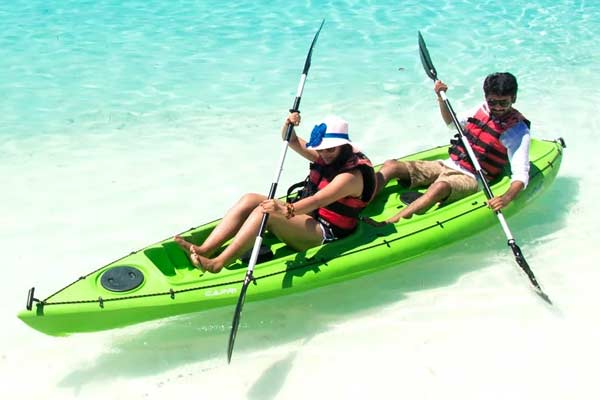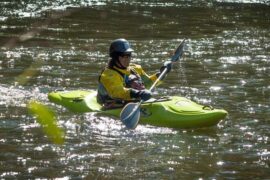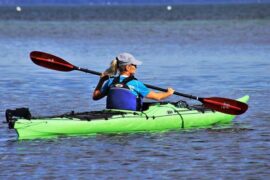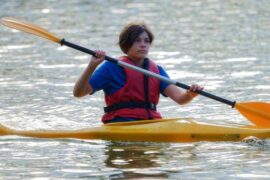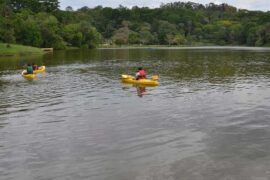Wind Limits for Fun and Games when Kayaking
Fun paddling in your kayak provides great entertainment as it has since ancient times, between 6,000 and 8,000 years ago. However, kayak safety remains a significant concern. Regardless of kayaking, it’s wise to recognize the wind’s safety limits.
Recognizing wind limits provides a safer kayaking experience. Generally, winds of 15 miles per hour or more become dangerous. Kayaking on small ponds, lakes, and slow-moving rivers can become dangerous in 10 mph winds if substantial waves become a factor.
Choosing Safer Kayak Venues
Most recreational kayakers stick to safer bodies of water, but these locations don’t always offer sufficient challenges for experienced and competitive kayakers.
The fetch, also known as the distance that wind can move over open water without being diverted by land, can prove deceptive. Paddlers often fail to detect the fetch on shore because the wind is blocked by land, and the water appears placid;
It’s best to choose a lake, river, or ocean venue with little open water for overwhelming fetch winds — such as areas protected on the windward side by a landmass. This strategy is called choosing to be in the lee of the windward shore.
Safety-conscious paddlers choose areas with a bit of fetch to enjoy their time on the water without constantly fighting the wind. Typically, the north side of land masses protects you from the high winds and waves generated by the fetch.
Kayak Safety Concerns
Most people use kayaks for recreational purposes on safer bodies of water, and most large lakes have miles of fetch that pose distinct challenges and threats.
When the wind picks up the water, the process creates large waves even in relatively calm waters. That doesn’t stop competitive people from kayaking on Lake Tahoe and Lake Superior, but kayakers need to learn how to read the wind.
Reading the Wind for Kayaking
Reading the wind for kayaking and sailing depends on two measurements: wind speed and wind direction.
Determining wind direction provides a base for calculating speed and wave size. Myriad clues about the wind surround kayakers, and you can learn to recognize these clues without relying on fancy electronics.
Traditional methods of measuring wind speed, direction, and fetch potential include:
-
A Wet Finger
Moisten your finger, and hold it up in the air. One side will dry faster and feel more relaxed or colder. That side indicates the direction from which the wind is blowing.
-
Wind on Your Face
Your face ranks as the body’s most sensitive area, and detecting wind against the face shows direction. Experienced sailors can even estimate the wind’s speed. Using your hearing also fine-tunes pinpointing the precise wind direction.
-
Install Yarn
I am installing a length of yarn up high, showing the continuous direction of the wind without needing to stop and use other detection methods.
Technical Method
If you’re a tech enthusiast, electronic masthead weather sensors provide precise wind direction on digital screens.
Anemometers
Anemometers are instruments that calculate wind speed with great precision to within plus or minus .5 millimeters per second. Anemometers are now available as an Android or iOS app for phones with a small sensor that easily fits in your pocket.
-
Constructing Your Anemometer
You can construct your version of an anemometer from four paper cups mounted sideways on a central rotating axis. The wind catches the cups and starts the assembly rotating. The faster the makeshift device rotates, the faster the wind is blowing.
Count the number of complete rotations the arms make in 30 seconds. Multiply the total by 2 to get the number of rotations per minute.
You’ll need an anemometer temporarily to calibrate your device and develop a formula for converting the measurements into miles per hour. Alternatively, learn the number of rotations that indicate safe wind conditions.
Estimating Wind Speed from Visual Cues
Visual cues can help you calculate a ballpark figure for wind speed. Smoke drift can show speeds of 1-3 miles per hour. Light breezes of 4 to 7 miles per hour can be detected by the feel of the air on your face. Gentle breezes of 8 to 12 miles per hour move leaves and twigs constantly.
Dangerous conditions for kayaking develop in fresh breezes that blow 19 to 24 miles per hour. Small trees and large branches begin to sway, and you can detect wavelets on large rivers or inland lakes.
Kayaking Risks of Sea Winds
Many conditions can cause your kayak to capsize out on the ocean, and that’s dangerous for even experienced sailors.
Even those who know how to make a wet exit and return to the kayak can forget their training when capsizing in high winds and alone on the ocean.
Ocean kayaking has grown increasingly popular despite the safety risks. Many paddlers enjoy moving up and down the beach following dolphins or using kayaks rigged with the latest fishing gear to catch trophy ocean fish.
The following safety tips can ensure that your fun and games don’t turn into tragedies:
Wear a Life Jacket
Kayaking is never safe if you don’t wear a life jacket — especially in ocean kayaking. The ocean generates tremendous power and hidden currents that prove life-threatening if you get separated from your jacket.
Choose Your Kayak Carefully
Longer kayaks are often recommended for ocean use, but sit-on-top styles provide the most significant safety.
These kayaks are completely sealed against water intrusion, so they pop onto the surface, facilitating getting out of the water. Kayak rentals are usually available for ocean kayaking.
Know When to Quit
The ocean often becomes too rough for kayaking. It would help if you didn’t kayak when the waves reach 2 or 3 feet. Regardless of your final decision, study the wave pattern, estimate wind speed and determine the fetch.
Prepare to Ensure a Watertight Kayak
Always confirm that your hatches are tightly shut, and any drain plugs are securely secured. That prevents water from getting inside your kayak, which can cause the kayak to sink.
Fun and Safe Adventures
Kayaks provide great fun and challenging adventures, but it’s necessary to understand the potential effects of strong winds for kayaking safety.
